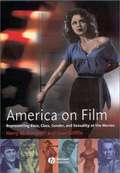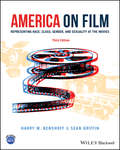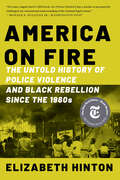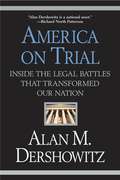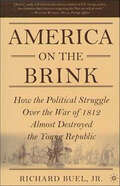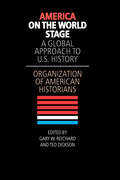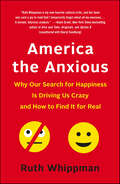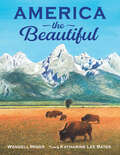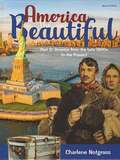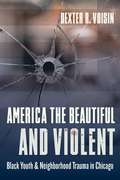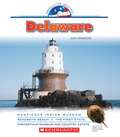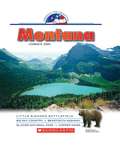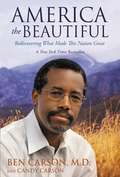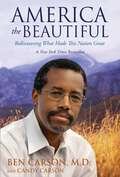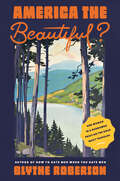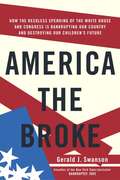- Table View
- List View
America on Film
by Harry M. Benshoff Sean GriffinAmerica on Film: Representing Race, Class, Gender, and Sexuality in the Movies, 2nd Edition is a lively introduction to issues of diversity as represented within the American cinema. Provides a comprehensive overview of the industrial, socio-cultural, and aesthetic factors that contribute to cinematic representations of race, class, gender, and sexuality Includes over 100 illustrations, glossary of key terms, questions for discussion, and lists for further reading/viewing Includes new case studies of a number of films, including Crash, Brokeback Mountain, and Quinceañera
America on Film: Representing Race, Class, Gender, and Sexuality at the Movies
by Harry M. Benshoff Sean GriffinAmerica on Film: Representing Race, Class, Gender, and Sexuality in the Movies is a lively introduction to issues of diversity as represented within the American cinema. Introduces issues of diversity as represented within the American cinema in a lively and accessible manner. Provides a comprehensive overview of the industrial, socio-cultural, and aesthetic factors that contribute to cinematic representations of race, class, gender, and sexuality. Is designed specifically for students and includes 101 illustrations, a glossary of key terms, questions for discussion, and lists for futher reading and further viewing. Includes case studies of a number of films, including The Lion King, The Jazz Singer, Smoke Signals, The Grapes of Wrath, and The Celluloid Closet. Each chapter features a concise overview of the topic at hand, a discussion of representative films, figures, and movements, and an in-depth analysis of a single film.
America on Film: Representing Race, Class, Gender, and Sexuality at the Movies
by Harry M. Benshoff Sean GriffinA comprehensive and insightful examination of the representation of diverse viewpoints and perspectives in American cinema throughout the 20th and 21st centuries America on Film: Representing Race, Class, Gender and Sexuality at the Movies, now in its third edition, is an authoritative and lively examination of diversity issues within American cinema. Celebrated authors and academics Harry M. Benshoff and Sean Griffin provide readers with a comprehensive discussion and overview of the industrial, socio-cultural, and aesthetic factors that contribute to cinematic representations of race, class, gender, sexuality, and ability. The book incorporates several different theoretical perspectives, including film genre, auteurism, cultural studies, Orientalism, the "male gaze," feminism, and queer theory. The authors examine each selected subject via representative films, figures, and movements. Each chapter also includes an in-depth analysis of a single film to illuminate and inform its discussion of the chosen topic. America on Film fearlessly approaches and tackles several controversial areas of representation in film, including the portrayal of both masculinity and femininity in film and African- and Asian-Americans in film. It devotes the entirety of Part V to an analysis of the depiction of sex and sexuality in American film, with a particular emphasis on the portrayal of homosexuality. Topics covered include: The structure and history of American filmmaking, including a discussion of the evolution of the business of Hollywood cinema African Americans and American film, with a discussion of BlacKkKlansman informing its examination of broader issues Asian, Latin/x, and Native Americans on film Classical Hollywood cinema and class, with an in-depth examination of The Florida Project Women in classical Hollywood filmmaking, including a discussion of the 1955 film, All that Heaven Allows Perfect for undergraduate and graduate students in film, media, and diversity-related courses, the book also belongs on the shelves of anyone interested in diversity issues in the context of American studies, communications, history, or gender studies. Lastly, it's ideal for use within corporate diversity training curricula and human relations training within the entertainment industry.
America on Fire: The Untold History Of Police Violence And Black Rebellion Since The 1960s
by Elizabeth HintonFrom one of our top historians, a groundbreaking story of policing and “riots” that shatters our understanding of the post–civil rights era. <P><P> What began in spring 2020 as local protests in response to the killing of George Floyd by Minneapolis police quickly exploded into a massive nationwide movement. Millions of mostly young people defiantly flooded into the nation’s streets, demanding an end to police brutality and to the broader, systemic repression of Black people and other people of color. To many observers, the protests appeared to be without precedent in their scale and persistence. Yet, as the acclaimed historian Elizabeth Hinton demonstrates in America on Fire, the events of 2020 had clear precursors—and any attempt to understand our current crisis requires a reckoning with the recent past. <P><P>Even in the aftermath of Donald Trump, many Americans consider the decades since the civil rights movement in the mid-1960s as a story of progress toward greater inclusiveness and equality. Hinton’s sweeping narrative uncovers an altogether different history, taking us on a troubling journey from Detroit in 1967 and Miami in 1980 to Los Angeles in 1992 and beyond to chart the persistence of structural racism and one of its primary consequences, the so-called urban riot. Hinton offers a critical corrective: the word riot was nothing less than a racist trope applied to events that can only be properly understood as rebellions—explosions of collective resistance to an unequal and violent order. As she suggests, if rebellion and the conditions that precipitated it never disappeared, the optimistic story of a post–Jim Crow United States no longer holds. <P><P>Black rebellion, America on Fire powerfully illustrates, was born in response to poverty and exclusion, but most immediately in reaction to police violence. In 1968, President Lyndon Johnson launched the “War on Crime,” sending militarized police forces into impoverished Black neighborhoods. Facing increasing surveillance and brutality, residents threw rocks and Molotov cocktails at officers, plundered local businesses, and vandalized exploitative institutions. Hinton draws on exclusive sources to uncover a previously hidden geography of violence in smaller American cities, from York, Pennsylvania, to Cairo, Illinois, to Stockton, California. <P><P>The central lesson from these eruptions—that police violence invariably leads to community violence—continues to escape policymakers, who respond by further criminalizing entire groups instead of addressing underlying socioeconomic causes. The results are the hugely expanded policing and prison regimes that shape the lives of so many Americans today. Presenting a new framework for understanding our nation’s enduring strife, America on Fire is also a warning: rebellions will surely continue unless police are no longer called on to manage the consequences of dismal conditions beyond their control, and until an oppressive system is finally remade on the principles of justice and equality.
America on Trial: Inside the Legal Battles That Transformed Our Nation
by Alan M. DershowitzOne might wonder how the trial of Mike Tyson or Lizzie Borden "transformed our nation" as opposed to other cases included by Dershowitz (law, Harvard U.), such as the Brown vs. Board of Education or Bush vs. Gore, but the reasoning behind the selection becomes clearer when he notes that the "basic criterion is passion" (i.e. a reflection of the passion of the times, arousing the passion of Americans, etc.). Basing his narratives of 64 American trials on the actual transcripts from the courtroom, he describes such cases as the trials of John Peter Zenger, Aaron Burr, Sacco and Vanzetti, Leopold and Loeb, the Rosenbergs, American Indian Movement activists, Bernhard Goetz, and John DeLorean. Annotation ©2004 Book News, Inc., Portland, OR (booknews.com)
America on the Brink: How the Political Struggle Over the War of 1812 Almost Destroyed the Young Republic
by Richard Buel Jr.The fascinating story of how New England Federalists threatened to dissolve the Union by making a separate peace with England during the War of 1812. Many people would be surprised to learn that the struggle between Thomas Jefferson's Republican Party and Alexander Hamilton's Federalist Party defined--and jeopardized--the political life of the early American republic. Richard Buel Jr.'s America on the Brink looks at why the Federalists, who worked so hard to consolidate the federal government before 1800, went to great lengths to subvert it after Jefferson's election. In addition to taking the side of the British in the diplomatic dance before the war, the Federalists did everything they could to impede the prosecution of the war, even threatening the Madison Administration with a separate peace for New England in 1814. Readers fascinated by the world of the Founding Fathers will come away from this riveting account with a new appreciation for how close the new nation came to falling apart almost fifty years before the Civil War.
America on the Eve of the Civil War
by Edward L. Ayers Carolyn R. Martin"This remarkable publication provides a captivating and brilliantly executed series of conversations among seventeen most impressive historians. These participants in a daylong conference focusing on the extraordinary years leading to the Civil War provide an incredible range of historical information that is both educational and exciting. Here is an opportunity to draw on a lively exchange between a substantial number of knowledgeable and entertaining scholars."--James Oliver Horton, author of Landmarks of African American History
America on the World Stage: A Global Approach to U.S. History
by Organization of American HistoriansRecognizing the urgent need for students to understand the emergence of the United States' power and prestige in relation to world events, Gary W. Reichard and Ted Dickson reframe the teaching of American history in a global context. Each essay covers a specific chronological period and approaches fundamental topics and events in United States history from an international perspective, emphasizing how the development of the United States has always depended on its transactions with other nations for commodities, cultural values, and populations. For each historical period, the authors also provide practical guidance on bringing this international approach to the classroom, with suggested lesson plans and activities. Ranging from the colonial period to the civil rights era and everywhere in between, this collection will help prepare Americans for success in an era of global competition and collaboration. Contributors are David Armitage, Stephen Aron, Edward L. Ayers, Thomas Bender, Stuart M. Blumin, J. D. Bowers, Orville Vernon Burton, Lawrence Charap, Jonathan Chu, Kathleen Dalton, Betty A. Dessants, Ted Dickson, Kevin Gaines, Fred Jordan, Melvyn P. Leffler, Louisa Bond Moffitt, Philip D. Morgan, Mark A. Noll, Gary W. Reichard, Daniel T. Rodgers, Leila J. Rupp, Brenda Santos, Gloria Sesso, Carole Shammas, Suzanne M. Sinke, Omar Valerio-Jimenez, Penny M. Von Eschen, Patrick Wolfe, and Pingchao Zhu.
America the Anxious: Why Our Search for Happiness Is Driving Us Crazy and How to Find It for Real
by Ruth WhippmanNAMED ONE OF THE 40 BEST BOOKS BY THE NEW YORK POSTA New York Times Editor's Choice pick“Ruth Whippman is my new favorite cultural critic...a shrewd, hilarious analysis.” —Adam Grant, New York Times bestselling author of Give and Take, Originals, and Option B (coauthored with Sheryl Sandberg)"I don't think I've enjoyed cultural observations this much since David Foster Wallace's A Supposedly Fun Thing I'll Never Do Again. Reading this book is like touring America with a scary-smart friend who can't stop elbowing you in the ribs and saying, "Are you seeing what I'm seeing?!" If you want to understand why our culture incites pure dread and alienation in so many of us (often without always recognizing it), read this book." —Heather Havrilesky, writer behind "Ask Polly" for New York Magazine and nationally bestselling author of How to Be a Person in the WorldAre you happy? Right now? Happy enough? As happy as everyone else? Could you be happier if you tried harder?After she packed up her British worldview (that most things were basically rubbish) and moved to America, journalist and documentary filmmaker Ruth Whippman found herself increasingly perplexed by the American obsession with one topic above all others: happiness. The subject came up everywhere: at the playground swings, at the meat counter in the supermarket, and even—legs in stirrups—at the gynecologist.The omnipresence of these happiness conversations (trading tips, humble-bragging successes, offering unsolicited advice) wouldn’t let her go, and so Ruth did some digging. What she found was a paradox: despite the fact that Americans spend more time and money in search of happiness than any other nation on earth, research shows that the United States is one of the least contented, most anxious countries in the developed world. Stoked by a multi-billion dollar “happiness industrial complex” intent on selling the promise of bliss, America appeared to be driving itself crazy in pursuit of contentment.So Ruth set out to get to the bottom of this contradiction, embarking on an uproarious pilgrimage to investigate how this national obsession infiltrates all areas of life, from religion to parenting, the workplace to academia. She attends a controversial self-help course that promises total transformation, where she learns all her problems are all her own fault; visits a “happiness city” in the Nevada desert and explores why it has one of the highest suicide rates in America; delves into the darker truths behind the influential academic “positive psychology movement”; and ventures to Utah to spend time with the Mormons, officially America’s happiest people.What she finds, ultimately, and presents in America the Anxious, is a rigorously researched yet universal answer, and one that comes absolutely free of charge.
America the Beautiful
by Wendell MinorClassic Americana and patriotism meet in this picture book version of the beloved song "America the Beautiful."Katharine Lee Bates's timeless and beloved poem alongside art by award-winning author and artist Wendell Minor, capturing the magnificent beauty of the United States. Celebrate America's ideals of togetherness and marvel at classic illustrations of her natural and historical wonders: from Yosemite National Park and the Garden of the Gods, to Mount Rushmore and Plymouth Plantation. This reissued edition includes an updated introduction, information about the poet, the composer of the song, the sheet music, a map and brief information about all twenty-one American locations depicted in the book.
America the Beautiful Part 1: America from 1000 to 1877
by Charlene NotgrassAmerica the Beautiful, collated in a chronological order, is a package where we learn about America in thirty units. Lessons include: Our American Story; God's Wonders; An American Landmark; An American Biography; Daily Life. The author of the book ensures that readers learn about God in the making of America.
America the Beautiful Part 1: America from 1000 to 1877
by Charlene NotgrassAmerica the Beautiful by Charlene Notgrass is a one-year American history, geography, and literature course designed for students in grades 5-8. It combines the flexibility and richness of a unit study with the simplicity of a textbook-based approach to history. Daily lessons guide your child chronologically through American history, highlighting key events, people, and places. This book has 75 lessons beginning with life in America before Europeans came and continuing through the first years after the Civil War.
America the Beautiful Part 2: America from 1800s to the Present
by Charlene NotgrassThis book is a continuation of America the Beautiful Part 1 in telling the American Story.
America the Beautiful Part 2: America from the Late 1800s to the Present
by Charlene NotgrassThis book has 75 lessons beginning with the late 1800s and continuing to modern times.
America the Beautiful and Violent: Black Youth and Neighborhood Trauma in Chicago
by Dexter VoisinWidespread media narratives portray an epidemic of neighborhood violence in urban areas—often ignoring the structural explanations advanced by community organizers fighting violence and activists such as those in the Movement for Black Lives. In this book, Dexter R. Voisin provides a compelling and social-justice-oriented analysis of current trends in neighborhood violence in light of the historical and structural factors that have reproduced entrenched patterns of racial and economic inequality. <P><P>America the Beautiful and Violent is built around the powerful voices and insights of black youth in Chicago and their parents and communities. Voisin interweaves their narratives with data, research findings, and historical accounts that provide context for their experiences. He highlights the broad historical, political, economic, and racial factors that shape the construction, concentration, and narratives of violence in black neighborhoods. Voisin explores these forces and the violence they produce; the behavioral health consequences of repeated exposures to neighborhood violence; and the ways youth, families, and communities cope with such traumas. America the Beautiful and Violent offers a set of practice and policy recommendations to address the patchwork inequality that leads to concentrated violence and to support children and adolescents struggling with the precarious conditions and threat of violence in their daily lives.
America the Beautiful: Delaware
by Ann HeinrichsLook for these special features in this book: SIDEBARS, CHARTS, GRAPHS, and original MAPS expand your understanding of what's being discussed--and also make useful sources for classroom reports. FAQs answer common Frequently Asked Questions about people, places, and things. WOW FACTORS offer "Who knew?" facts to keep you thinking. TRAVEL GUIDE gives you tips on exploring the state--either in person or right from your chair! PROJECT ROOM provides fun ideas for school assignments and incredible research projects. Plus, there's a guide to primary sources--what they are and how to cite them.
America the Beautiful: Montana
by Ann HeinrichsWelcome to Montana! Mountains, rivers, and plains. A trip through time. Government by the people. Montanans at work. Getting to know Montanans. Let's explore Montana!
America the Beautiful: Montana
by R. Conrad SteinMontana is one of the nations largest states, but it is home to very few large towns or cities. Rather, it is defined by its vast wilderness areas, which range from the high peaks of the Rocky Mountains to the rolling hills and flatlands of the Great Plains. Readers will find out how Montana was settled and what role it has played in U.S. history. They will also explore the states rich culture and traditions.
America the Beautiful: North Carolina
by Ann HeinrichsNorth Carolina Is A Place Of Varied Landscapes. Its mountains are among the tallest and most rugged east of the Mississippi River, and its coastal plains are low and flat. High in the western mountains rises Mount Mitchell. At 6,684 feet (2,037 meters), it's the state's highest point. Hundreds of miles to the east, the land drops down to sea level along the Atlantic coast.
America the Beautiful: Rediscovering What Made This Nation Great
by Ben Carson Candy CarsonWhat is America becoming? Or, more importantly, what can she be if we reclaim a vision for the things that made her great in the first place? In America the Beautiful, Dr. Ben Carson helps us learn from our past in order to chart a better course for our future. From his personal ascent from inner-city poverty to international medical and humanitarian acclaim, Carson shares experiential insights that help us understand. . . what is good about America. . . where we have gone astray. . . which fundamental beliefs have guided America from her founding into preeminence among nations. Written by a man who has experienced America's best and worst firsthand, America the Beautiful is at once alarming, convicting, and inspiring. You'll gain new perspectives on our nation's origins, our Judeo-Christian heritage, our educational system, capitalism versus socialism, our moral fabric, healthcare, and much more. An incisive manifesto of the values that shaped America's past and must shape her future, America the Beautiful calls us all to use our God-given talents to improve our lives, our communities, our nation, and our world.
America the Beautiful: Rediscovering What Made This Nation Great
by Ben CarsonWhat is America becoming? Or, more importantly, what can she be if we reclaim a vision for the things that made her great in the first place? In the Zondervan ebook, America the Beautiful, Dr. Ben Carson helps us learn from our past in order to chart a better course for our future. From his personal ascent from inner-city poverty to international medical and humanitarian acclaim, Carson shares experiential insights that help us understand … what is good about America … where we have gone astray … which fundamental beliefs have guided America from her founding into preeminence among nations Written by a man who has experienced America’s best and worst firsthand, America the Beautiful is at once alarming, convicting, and inspiring. You’ll gain new perspectives on our nation’s origins, our Judeo-Christian heritage, our educational system, capitalism versus socialism, our moral fabric, healthcare, and much more. An incisive manifesto of the values that shaped America’s past and must shape her future, America the Beautiful calls us all to use our God-given talents to improve our lives, our communities, our nation, and our world.
America the Beautiful: Together We Stand (Into Reading, Read Aloud Module 6 #1)
by Katharine BatesNIMAC-sourced textbook
America the Beautiful: West Virginia
by Ann HeinrichsWest Virginia's name perfectly describes its origin. The land that is now West Virginia was once the western part of Virginia. In the 1600s, the Virginia Colony was named for Queen Elizabeth I of England. Since she never married, she was known as the Virgin Queen. When the Civil War (1861-1865) broke out, Virginia seceded, or withdrew, from the Union. But people in Virginia's western counties had a mind of their own. They didn't want to secede. Instead, they formed their own government and called their new state West Virginia.
America the Beautiful?: One Woman in a Borrowed Prius on the Road Most Traveled
by Blythe RobersonThe author of How to Date Men When You Hate Men examines Americans’ obsession with freedom, travel, and the open road in this funny, entertaining travelogue that blends the humorous observations of Bill Bryson with the piercing cultural commentary of Jia Tolentino.For writer and comedian Blythe Roberson, there are only so many Mary Oliver poems you can read about being free, and only so many times you can listen to Joni Mitchell’s travel album Hejira, before you too, are itching to take off. Canonical American travel writers have long celebrated the road trip as the epitome of freedom. But why does it seem like all those canonical travel narratives are written by white men who have no problems, who only decide to go the desert to see what having problems feels like?To fill in the literary gaps and quench her own sense of adventure, Roberson quits her day job and sets off on a Great American Road Trip to visit America’s national parks.America the Beautiful? is a hilarious trip into the mind of one of the Millennial generation’s funniest writers. Borrowing her Midwestern stepfather’s Prius, she heads west to the Loop of mega-popular parks, over to the ocean and down the Pacific Coast Highway, and, in a feat of spectacularly bad timing, through the southwestern desert in the middle of July. Along the way she meets new friends on their own personal quests, learns to cope with abstinence while missing the comforts of home, and comes to understand the limits—and possibilities—of going to nature to prove to yourself and your Instagram followers that you are, in fact, free.The result is a laugh-out-loud-while-occasionally-raging-inside travelogue, filled with meditations and many, many jokes on ecotourism, conservation, freedom, traffic, climate change, and the structural and financial inequalities that limit so many Americans’ movement. Ultimately, Roberson ponders the question: Is quitting society and going on the road about enlightenment and liberty—or is it just selfish escapism?
America the Broke
by Gerald J. Swanson“One day soon, our government will suddenly run out of cash, unable to meet its payments, leaving the United States as bankrupt as any banana republic. We are far more vulnerable than most Americans realize. . . With a debt of $7. 3 trillion, if interest rates were to hit the levels we saw 20 years ago, it would take every nickel collected in income taxes just to pay the interest on our existing debt. There would be no money left for defense, or homeland security, or education, or Social Security. This scenario is hardly fiction. That the United States of America can literally go broke is no longer a fantasy but likelihood—unless we stop the train now speeding us to Armageddon. If we do not get our financial house in order, and soon, our great nation will collapse under the weight of its financial obligations. I believe we can prevent the catastrophe. But time is short. In the final reckoning, it’s up to us to do what’s needed to save America’s future. ”—fromAmerica the BrokeThe dirty little secret that neither George W. Bush nor Congress are willing to confront—that America’s reckless spending, disastrous deficits, and exploding debt are speeding our great nation to financial ruin. Imagine a world in which you lose your job because your company goes under, your retirement money disappears, the value of your home tumbles overnight, your bank stops allowing cash withdrawals, and your ATM card is canceled. The price of groceries has risen so fast that you don’t have the money to pay for them at the check-out counter . . . and the country is bankrupt. That is exactly the future that economist Gerald J. Swanson sees America hurtling toward—unless we rein in our country’s reckless spending. InAmerica the Broke, Swanson, coauthor of the runawayNew York TimesbestsellerBankruptcy 1995, argues that the United States is on the brink of financial collapse. Thanks to George W. Bush’s two tax cuts, the White House and Congress’ escalation of domestic spending, two wars, and an economic recession, what was a $200 billion annual surplus three years ago under Bill Clinton has become a river of red ink. The White House’s official projected deficit for 2004 is $521 billion—the largest deficit in U. S. history. With a national debt spiraling upward of $7. 3 trillion, a huge trade deficit, and personal debt at an all-time high, we are standing at the edge of a financial abyss that could undermine the financial security of our families and our children’s children. “Deficits don’t matter,” claim Vice President Dick Cheney and other members of the Bush Administration. But the facts revealed inAmerica the Brokepaint an alarming picture. Next year’s projected deficit will exceed the amount all our cities spend on police, fire protection, medical care, and every other civil service in an entire year. It is more than we could save from abolishing Medicare and Medicaid completely. Therealdeficit—the deficit the government doesn’t want you to know about—including the hidden funds we “borrow” from Social Security is nearly $1trillion. Rising interest rates alone could trigger staggering payments on our skyrocketing debt, soaking up every dollar the government takes in, leaving America bankrupt. What does this mean for you and me? If the dollar goes into free fall, banks could close, businesses go bankrupt, real estate values crumble, and middle-class families could lose everything they own. But there is hope. We can save ourselves—ifwe demand that our political leaders act now to eliminate the deficit and reduce the debt. In a year of deficit de

